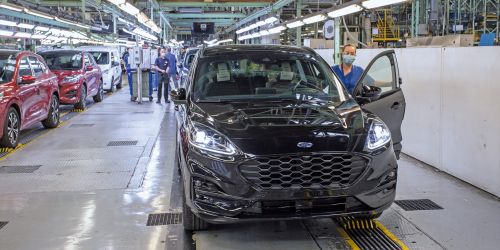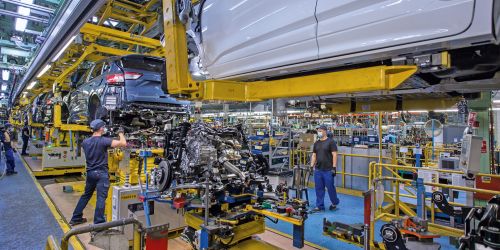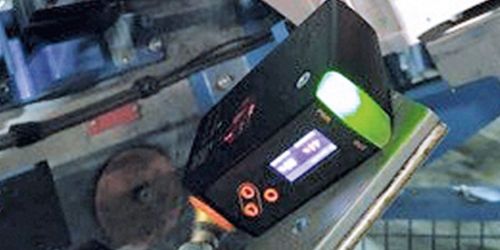How the PMD Profiler ensures error-free construction of car bodies

Following in the spirit of its founder, Ford continues to focus on innovative technologies and automation solutions to combine and increase quality and efficiency in vehicle production. This also applies to the plant in Valencia, Spain, where ifm's contour sensor PMD Profiler looks very closely during the production of the Ford Kuga.
Even back then, Henry Ford recognised the importance of maintaining strict quality assurance standards, using components of the highest quality throughout and with as few deviations as possible to ensure efficient mass production and consistent vehicle quality. These principles have remained to this day, but car body construction alone is now much more complex and multi-faceted. Quality assurance in modern vehicle production involves many rigorous procedures.
A particular challenge emerged in the production of Ford Kuga, which is manufactured alongside other models at Ford’s plants in Valencia, Spain. The actual work step involves welding a small, completely flat reinforcing sheet onto a larger assembly. “The machine operator inserts a large body shell component into a turntable before placing a smaller metal sheet on top,” explains Mario Eschweiler, Manufacturing Engineer Bodyside at Ford Europe. He oversaw the corresponding quality assurance project from the German Ford site in Cologne. “It’s important at this stage to be able to reliably recognise whether the smaller metal sheet is positioned correctly or not. Further, you also need to make sure that two or more of the reinforcing sheets have not been loaded inadvertently. During the next step, the turntable is rotated and a robot welds and removes both components.”

In order to ensure that, in the end, the quality of the vehicle is right down to the smallest detail, every production step must be carried out precisely. Image source: Ford Werke GmbH.
A task where camera systems give up
Due to this fixed production sequence, a conventional photoelectric distance sensor for presence detection was not an option. The reason: It would not have been possible to install the sensor without it getting in the way of machine operators or robots. When explaining the selection of suitable solutions, Eschweiler says: “Inductive and mechanical sensors were not suitable for the same reason. Single-sided inductive double sheet detection was ruled out due to the diminutive dimensions of the small part and also the associated positioning capability.” Further: The diminutive dimensions and the flat surface already posed a demanding challenge. In addition, strongly fluctuating lighting conditions caused by sunlight during the day and artificial light at night made the task even more difficult. “As initial tests showed, these requirements pushed conventional camera systems to the limits of their capabilities and beyond,” explains Eschweiler. During the commissioning phase, the tested camera solutions generated a misreading rate of one percent and over. “However, the criterion that made use of the camera system impossible was another aspect: We couldn’t make sure that only one reinforcing sheet was inserted at a time.” All in all, the perfect challenge for the PMD Profiler from ifm.


Picture 1: Strongly fluctuating lighting conditions caused by sunlight during the day and artificial light at night made the task even more difficult – the PMD Profiler solved it. Image source: Ford Werke GmbH. Picture 2: The PMD Profiler detects whether the smaller metal sheet is positioned correctly or not. Image source: Ford Werke GmbH.
The PMD profiler reliably ensures correct usage and assembly of components. To do this the optoelectronic line scanner projects a laser line on the working area that is being tested and determines the height profile by means of the reflected light. If the height profile matches the profile specified during teach-in, the PMD profiler detects a correct assembly If the profile deviates beyond a freely definable tolerance value, the sensor generates an error signal. With a measuring accuracy of 500µm, the PMD profiler detects even the smallest deviations – and thus also whether the thin reinforcing plate is missing, or if too many of them have been placed. Correct alignment of the component can also be tested by comparing the actual height profile with the specified height profile. The PMD profiler's working precision is matched by its tolerance in terms of its working environment: Immunity to extraneous light, independence of distance and flexibility in positioning of the component along the laser line.
A technically robust solution
Both in an initial test setup and during a functional demonstration by ifm’s German automotive experts as well as in the actual test phase, which was supervised by ifm’s Spanish subsidiary, the line scanner managed to convince the project participants at Ford. The result: “By using the PMD Profiler, we have been able to solve the task in a technically proficient way, thereby effectively minimising downtime through reliable error detection,” says Eschweiler. “Today, the task is solved excellently during ongoing operation. This point is underlined by the fact that the number of errors per thousand was just 0.2 during the first month of regular operation. It is quite likely that these were real incorrect loads where the Profiler correctly pointed out the incorrect load.”
Conclusion
With the PMD profiler, Ford was able to reliably ensure the quality of the manufacturing step. However, the German project manager attributes that to more than the high performance level of the line scanner alone: "We experienced consistent, competent and personal support from the industry experts of ifm throughout the entire project – both here in Germany and also on site in Spain. That is also a crucial factor as I see it, which contributed to finding the ideal solution and implementing it successfully."
